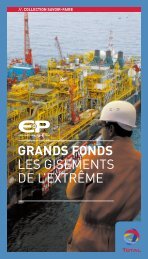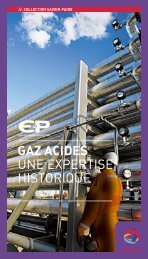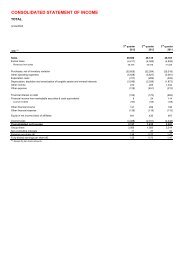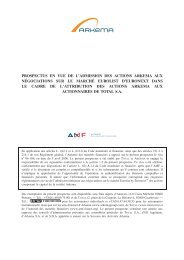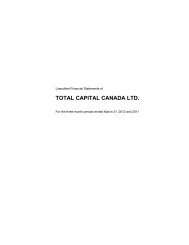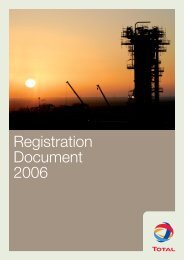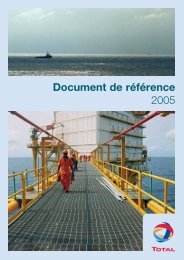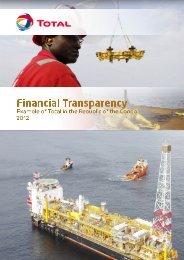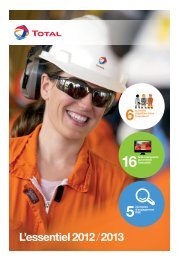Registration Document 2005 - Total.com
Registration Document 2005 - Total.com
Registration Document 2005 - Total.com
Create successful ePaper yourself
Turn your PDF publications into a flip-book with our unique Google optimized e-Paper software.
The consolidated balance sheet and in<strong>com</strong>e statement showing the<br />
reconciliation from French GAAP to IFRS is provided, respectively,<br />
in exhibits 1 and 2 of the current note.<br />
Modification of the Group’s accounting principles<br />
The main modifications of the Group’s accounting principles<br />
concern the following subjects:<br />
Note 32.1: inventories<br />
In accordance with IAS 2, the Group values inventories of<br />
petroleum products in the financial statements according to the<br />
FIFO (First-In, First-Out) method and other inventories using the<br />
weighted-average cost method.<br />
However, in the note setting forth information by business segment,<br />
the Group will continue to present the results of its Downstream<br />
segment according to the replacement cost method and those of<br />
its Chemicals segment according to the LIFO (Last-In, First-Out)<br />
method in order to ensure the <strong>com</strong>parability of the Group’s results<br />
with those of its leading <strong>com</strong>petitors, mainly North American.<br />
Inventory valuation using the FIFO method, which implies the<br />
cancellation of the reserve for crude oil price changes, is reflected<br />
by an increase in the value of inventories and an increase in<br />
shareholders’ equity as of January 1, 2004.<br />
The effect on 2004 net in<strong>com</strong>e amounts to 478 million euros for<br />
fully consolidated entities.<br />
Note 32.2: Treasury shares<br />
In application of IAS 32 relating to financial instruments, treasury<br />
shares recorded under marketable securities in the financial<br />
statements prepared according to French GAAP, have been<br />
eliminated from shareholders’ equity.<br />
Note 32.3: Employee benefits<br />
The Group has decided to record unrecognized net actuarial losses<br />
and gains as of December 31, 2003 through retained earnings in<br />
accordance with IFRS 1.<br />
As of the transition date, the negative impact on shareholders’ equity<br />
results from a decrease in other non-current assets (pension assets)<br />
and an increase of provisions for employee benefit obligations.<br />
The effect on net in<strong>com</strong>e under IFRS results from the cancellation<br />
of the amortization of actuarial gains and losses as well as<br />
from immediate recognition of prior service costs vested (plan<br />
amendments) which were previously spread out under French GAAP.<br />
Appendix 1 – Consolidated financial statements<br />
Notes to the consolidated financial statements 9<br />
Note 32.4: Other IFRS restatements<br />
The other restatements at the transition date are as follows:<br />
Note 32.4a: Component-based approach<br />
Pursuant to IAS 16 concerning tangible assets, the Group applies<br />
the <strong>com</strong>ponent-based approach. The cost of major turnarounds<br />
of refineries and large petrochemical units are capitalized<br />
and depreciated over the period of time between two major<br />
turnarounds.<br />
The effect on shareholders’ equity as of January 1, 2004 results<br />
from the capitalization of turnaround and major inspection<br />
<strong>com</strong>ponents (valued on the basis of the costs of the last major<br />
turnaround) net of the corresponding depreciation and the reversal<br />
of provisions for turnaround costs accounted for under French<br />
GAAP. This restatement concerns primarily the major refineries<br />
within the Downstream segment and, to a lesser extent, the<br />
petrochemical units within the Chemicals sector.<br />
Note 32.4b: Impairment of assets<br />
IAS 36 provides for the testing of assets for impairment purposes<br />
by <strong>com</strong>parison of the assets’ carrying values with the associated<br />
discounted future cash flows. The accounting policy previously<br />
applied by the Group (FAS 144) provides that the calculation be<br />
based on undiscounted cash flows.<br />
As of the transition date, this difference in methodology results in<br />
the impairment of some fixed assets mainly within the Upstream<br />
segment.<br />
Note 32.4c: Financial instruments (excluding treasury shares)<br />
The Group’s application of IAS 32 and IAS 39 as of January 1, 2004<br />
leads to the following restatements:<br />
• publicly-traded equity securities<br />
Publicly-traded equity securities are classified as “available for<br />
sale” and are therefore valued at fair value. Changes in fair value<br />
of these securities are recorded through shareholders’ equity.<br />
•<br />
derivatives<br />
Derivatives are now recorded in the balance sheet whereas they were<br />
treated as off-balance sheet <strong>com</strong>mitments under French GAAP.<br />
TOTAL - <strong>Registration</strong> <strong>Document</strong> <strong>2005</strong><br />
221




